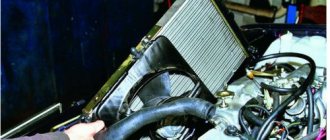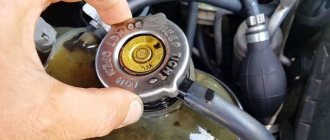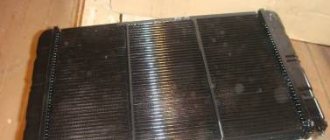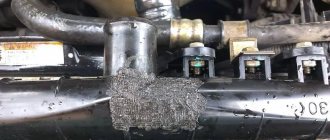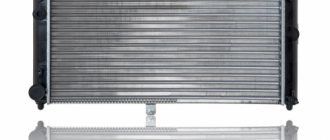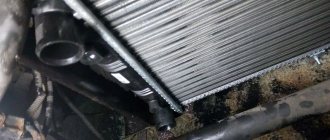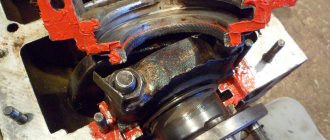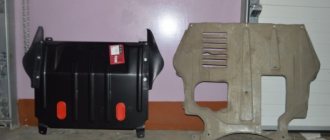Since the internal combustion engine is a heat engine, during its operation it generates excess heat that must be removed. A liquid radiator, inside of which antifreeze circulates, helps with this. Due to, for example, high efficiency with relatively small dimensions, automobile engines also have additional forced cooling. Simply put, car engines have a combined cooling system in which the liquid system does most of the work of removing heat. Air cooling elements are activated only at high coolant temperatures.
Please note: when talking about the engine cooling system, they often use the concept of antifreeze temperature. However, there are times when the engine oil also needs to be cooled. The oil comes into direct contact with engine components, which become very hot. If the oil temperature becomes critically high, it will lose many of its properties, which will be critical for the rubbing parts of the engine. The task of cooling the lubricant is taken over by an oil cooler, otherwise called an oil cooler. Avto.pro decided to look into its structure and key features.
Purpose of the oil cooler
The engine oil cooler is designed to protect the power unit from wear, which can be caused by oil overheating. This is especially true these days, when molded engines have become widespread and temperature control temperatures have increased significantly. If previously it was enough to create a reliable antifreeze cooling system, now a separate system for regulating the temperature of the engine oil is required. There are several reasons:
- At high temperatures, the oil begins to boil away, which leads to a decrease in its volume and the formation of deposits;
- Along with the decrease in volume at high temperatures, the viscosity of the oil also decreases - it should be neither low nor too high;
- The lubricant quickly ages and loses its properties.
Despite the fact that modern oils have a well-thought-out set of additives, even they cannot protect it from overheating. As a rule, engine oil heats up a little more than antifreeze: 90-100°C versus 80-90°C . Additives demonstrate their effectiveness up to temperatures of 100°C (with rare exceptions), and when overheated they begin to work or decompose. As a result, after prolonged overheating, the engine oil can only be replaced - ignoring this problem can result in engine failure. The problem can be avoided by using an oil cooler, in which the lubricant is cooled to the optimum temperature.
Why don't they install it on some cars?
It's just not necessary. For example, in passenger cars, high-speed motors perfectly pump antifreeze through the system, removing excess temperature. And there are no such high loads of several tons as on trucks, so there is simply no reason to install an oil cooler there.
This is how the material turned out, I think it was useful to you. Be sure to write your comment, and I say goodbye to you - sincerely your AUTOBLOGGER.
Similar news
- Fuel consumption after oil change. Is there an impact? More details + in…
- Why does a car drive poorly in hot weather? Details + video version
- The timing chain knocks (rattles), whether cold or hot. How to determine...
Oil radiator design
At its core, this is still the same radiator with some modifications. Firstly, it should be relatively small, because the engine cooling system already takes up a lot of space, and the oil cooler may even be located right in front of the main radiator. Secondly, the layout of the radiator must be well thought out - there should be no pressure drops . Conventionally, oil radiators are divided into two types:
- With natural cooling. The walls of the radiator are blown with oncoming air as the vehicle moves, which leads to cooling of the oil circulating inside the device;
- With forced cooling. The radiator is blown not only by a counter flow of air, but also by a fan.
Both types of radiators have the same design. This is a series of steel or aluminum tubes of oval cross-section, and each of the tubes, as a rule, has a spiral wound on it - this allows you to increase the heat transfer area. In some radiator models, cooling plates . Another element of the oil cooler: a pair of tanks (lower and upper). Fittings are welded to the tanks, to which the oil supply and drainage pipes are connected. Of course, the radiator has special fasteners that allow it to be installed on a car.
As practice shows, passing through radiator tubes without a special fan, engine oil is cooled by 10°C . Forced cooling does not seriously increase the cooling temperature when the car is moving at high speeds, but at low speeds it is extremely effective. The main factors influencing the efficiency of the radiator are the following:
- Material (heat transfer efficiency factor);
- Tube geometry;
- The temperature difference between the oil and the air surrounding the radiator.
It is also impossible not to talk about such an important element of a good radiator as an additional turbine. It improves the circulation of lubricant inside the radiator and prevents blockages. As a result, oil of almost any viscosity circulates properly in the radiator. Cases where the oil turns out to be too viscous and its movement through the radiator tubes is difficult should rather be attributed to engine problems - even an oil cooler without a turbine can “drive” the oil through the cooling circuit.
Top brands
At the moment, you can see a huge number of oil devices on the market, but the most popular and modern among all brands are the following.
The Honeywell company was founded back in 1906 by engineer Mark Honeywell. Honeywell was a pioneer in the home plumbing and heating industry and is still known for producing high-quality products such as the Honeywell 7-Day Programmable Thermostat and portable air conditioners.
Founded in 1902, the company is a renowned manufacturer of small household appliances based in Treviso, Italy. Its espresso machines and coffee makers are among the best in the industry, as is its large line of portable heaters.
Pelonis has been in the portable heating and cooling industry for over 25 years. Based in Exton, Pennsylvania, the company manufactures a reliable line of portable air conditioners, fans and radiators in a variety of styles.
It's a compact appliance manufacturer that was started over 15 years ago by Luke Peters, who sold portable air conditioners and other home appliances out of his garage. Today, the company has diversified significantly to offer all types of small household appliances to suit every taste.
Prices for oil heaters
- 1600-2000 RUR: This price range will give you a limited selection of portable oil heaters. Very tiny and compact models that are suitable for heating small spaces, or models without many additional features, tend to be in this price range.
- 2500-4000 RUR: This price range offers many options for oil heaters. Here you will find additional options such as programmable timers, remote controls and digital displays.
- Over RUB 4,500: Here you will get access to the most futuristic, sleek oil heater designs that will come equipped with all the modern features such as incremental digital temperature control, energy-saving operating modes and much more.
Advantages and disadvantages of oil radiators
An engine oil cooler is not a required part of most cars. For example, such radiators are installed on cars with a powerful engine, such as BMW 335i E92 . Also, almost all agricultural machinery, trucks and many van models need oil cooling. the advantages of oil radiators , but let's list them all. The oil cooler provides:
- Stability of lubricant temperature;
- Maintaining normal temperature of the power unit;
- Increasing the service life of engine oil.
Spare parts for BMW 2500
Windshield washer fluid
2500 M30B25 (32/40INAT)
Spare parts for Mazda 2
Rear engine mount (support) 1.4 CD F6JA
Despite the obvious advantages, the oil cooler, as stated, is an optional component for most cars. Consequently, it places an obligation on the driver to promptly diagnose and maintain it. Here are the disadvantages of an oil cooler:
- It needs maintenance, like cleaning the surface;
- More lubricant needs to be poured into the oil system - some of its volume will be “taken” by the radiator;
- Quite a high price (exception: radiators from lower-level packagers and Asian manufacturers).
As you can see, the advantages of oil coolers look more convincing than their disadvantages. For this reason, they are sometimes installed on cars standard equipment did not include such devices. We'll talk about this, but for now let's figure out how to identify a faulty oil radiator.
Where is?
Depending on the design features, the automatic transmission oil cooler can be located in the box itself (in the pan) or be integrated into the main heat exchanger. The latter scheme is more thoughtful and universal.
However, this method of placement also has disadvantages. For example, if a breakdown occurs in one of the two heat exchangers in the housing, antifreeze and oil will mix with each other. And the price of such a radiator itself is an order of magnitude higher. When disassembled, you can buy it for 5-10 thousand rubles.
What you should know about malfunctions
The oil radiator is operated under rather harsh conditions, but the pressure inside the device is not very high, which a positive effect on the service life. As a rule, car enthusiasts are faced with the need to replace radiators every 3-5 years, although in some cases replacement may be required earlier. It is worth paying attention to the following things:
- Increase in oil temperature;
- The appearance of dark deposits on the walls of the expansion tank of the cooling system;
- Presence of oil leaks.
Let us immediately note one important point: the circulation of coolant and the circulation of oil in their respective systems are interconnected . If the circuits become leaky, one fluid can mix with another, which will have a detrimental effect on the engine. For example, oil may get into the expansion tank. It is strictly forbidden to operate a car with such a malfunction - a seemingly insignificant breakdown in the long term will certainly lead to engine malfunction.
It is recommended to carry out a visual inspection of the oil cooling radiator once a year, or even more often. Oil leaks, dark deposits and greasy spots will indicate that the radiator is depressurized. More often you can observe a violation of the integrity of the oil supply and drainage pipes. Oil may leak around the fitting . These elements of the oil system should be checked first. A less common problem is a violation of the integrity of the radiator itself. Although the radiator is made of metal, its tubes have low mechanical strength - gravel from the road can pierce one of the tubes.
Selecting an oil cooler
If your car has a standard “supplemented” oil system, then you can search for its components using the VIN code, the parameters of your vehicle, or the radiator code. It’s easier to search for car parameters in online stores - this gives a fairly accurate result. This way you can find codes for both the original radiator and the closest analogues. If the standard equipment of your car did not include an oil cooler, then you will have to select it yourself. Here's what to remember:
- It is better to install the oil cooler together with a temperature sensor and an oil pressure sensor;
- Some models of oil coolers have a built-in fan, but their installation is very difficult, and in some cases it is almost impossible;
- To install the sensors properly, you will need a spacer for the oil filter;
- When choosing between a spacer with or without a thermostat, it is better to give preference to the first option;
- The location for installing radiators must be selected taking into account the fact that the oil supply and drain pipes should not sag.
You can often see branded oil cooler installation kits on sale. This kit may not be cheap, but we do not recommend saving. Also, you should not save on tubes, adapters, fittings and other “little things” that may not be included in the kit - how long the entire oil cooling system will work before depressurization due to mechanical stress or natural aging of materials will depend on the quality of its execution. As for choosing the radiator itself for a non-standard installation, everything will depend on the engine parameters of your car. Many experts advise first installing temperature and oil pressure sensors, and then selecting a radiator based on their readings.
It is better to entrust the installation of the radiator to a specialist. If the device does not have special fasteners, the technician will make them himself. As a rule, the radiator is placed in front of the main engine cooling radiator. The technician will also install a special spacer. It often happens that the spacer does not fit into the regular place of the oil filter - then you will need to install something like a gasket with it. In this case, a fairly long fitting may be required for further installation of the spacer.
Installation
Installation of the heater does not require special skills and knowledge. If it is a hanging model, it is mounted on brackets that are pre-installed at the required distance from each other. If the model is mobile on wheels, then all that is needed for installation is to determine the safest place near the outlet. It is worth considering that there should be no obstacles in the heater’s path - curtains, sofas or chests of drawers. It is best to install it in the central part of the room in the first 2-3 hours of operation. After the space has warmed up, it is moved to a more comfortable distance - near a wall or fireplace.
Excursion to the manufacturers
When choosing a suitable oil cooling radiator, you should pay attention to the manufacturer. If you understand engine radiators, then everything is simple: look for oil cooler radiators in their assortment - almost all major radiator manufacturers produce them too. Unfortunately, their products cost a lot of money, but the price corresponds to the quality. Radiators from the following companies are worthy of attention:
- Nissens (Denmark);
- NRF (Netherlands);
- Hella (Germany):
- AVA (Netherlands).
Not as high quality, but much cheaper analogues are offered by ]DP Group[/anchor] (Turkey), Polcar (Poland), 3RG (Spain), Vika (Taiwan), Dello (Germany), Thermotec (Poland). In fact, these are packers selling products from Turkish, Chinese and Taiwanese factories. There is nothing wrong with Asian auto parts; the cheapest auto parts from these countries are another matter. As a rule, they have a high percentage of defects and non-compliance with the original geometry. In their production, low-quality raw materials are often used. In the case of radiators, this is critical, so Avto.pro advises buying much higher quality products from companies from the list above.
Conclusion
An engine oil cooling radiator is not included in the standard equipment of all cars, but it copes so effectively with the task of controlling the oil temperature and protecting the engine that many car enthusiasts decide to install this device on their vehicles. The radiator cannot be called a durable car part - it has little mechanical strength, and the connecting elements of the oil system tend to gradually age and depressurize. An engine oil leak should never be ignored, and in systems with a special cooler it can also be observed in the radiator. If the car requires replacement of the oil cooler, we recommend purchasing spare parts from well-known European manufacturers. Although they will not be cheap, they will guarantee the efficiency and durability of the engine oil cooling system.
Expert advice
- Always turn off your oil heater when leaving the house to minimize the risk of fire.
- If you have small children, be sure to place your oil heater in a space that minimizes the risk of accidental knocking over or changing temperature settings by prying hands.
- Be sure to keep the heater in a well-ventilated area away from curtains, furniture, or clutter to avoid accidental overheating or burning.
- Always read online reviews before purchasing to see what other consumers have experienced with the specific model you are interested in.

